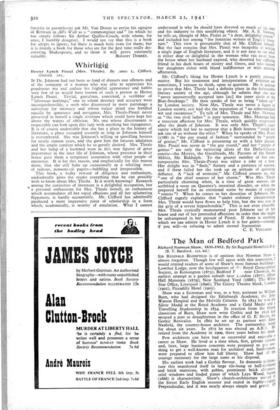The Man of Bedford Park
Richard Norman Shaw, 1831.1912. By Sir Reginald Blomfield, R.A. (B. T. Batsford. 12 s. 6d.) SIR REGINALD BLOMFIELD is of opinion that Norman Shaw is almost forgotten. Though few will agree with this contention, I would remind readers of some of Shaw's most famous buildings: Lowther Lodge, now the headquarters of th-: Royal Geographical Society, in Kensington (1873); Bedford P . near Chiswick, the earliest attempt at a garden suburb near London (1877); Albert Hall Mansions (1879); New Scotland Yard (1888); The White Star Office, Liverpool (1896); The Gaiety Theatre block, London (1902); Piccadilly Hotel (1905). Shaw was a Scotsman and was, as a boy, assistant to William Burn, who had designed the Edinburgh Academy, the John Watson Hospital and the Melville Column. In 1853 he won the Silver Medal at the Royal Academy and a Gold Medal and Travelling Studentship in 1854. In reaction from the Greek classicism of Burn, Shaw now went Gothic and by 1858 had secured a post as draughtsman in the office of G. E. Street, the Gothic Revivalist. In 1[162 he set up as partner with Eden Nesfield, the country-house architect. The partnership lasted for about six years. In 1872 he was elected an A.R.A. He retired from the Academy in 1909, three years before his death. Few architects can have had so successful and enjoyable 3 career as Shaw. He lived at a time when, first, private persons and, later, large business concerns were prepared to pay anY thing to get a well-known man for architect and, furthermore, were prepared to allow him full liberty. Shaw had all the courage necessary for the large sums at his disposal. His earliest work had a Gothic flavour. In domestic architec- ture this manifested itself in large tile-hung or half-timbered and brick mansions, with gables, prominent brick chimneys' oriel windows and leaded panes of which Legs Wood, Sussex (1868) is characteristic. Shaw's church-architecture started is the Street Early English manner and ended in highly-original, Perpendicular, and it was nearly always simple and grand. all his work, it is the most consistently satisfactory and reminds one of the architecture of Sedding.
Shaw's return to the Classic style—how different a classic from the chaste Greek of William Burn!—started in a tentative manner, with an early Renaissance fireplace here and an Eliza. bethan ceiling there. Finally, by the middle 'seventies, Shaw was building brick houses which were known as " Queen Anne.. they had no longer leaded wondows, but - heavy white woad glazing bars ; no longer half-timbered gables but stepped and rounded Dutch motives. Sir Reginald quotes the amusing Ballad of Bedford Park (1880 :
Here trees are green and bricks are red and clean the face of man. "
" We'll build our houses here," he said, " in style of good Queen Anne."
For floors were stained -and polished
and every hearth was tiled, And Philistines abolished by Culture's gracious child.
And Abbey .(he the artist, malicious little wretch) Said it made him feel like walking through a water-colour sketch.
Now he who loves aesthetic cheer and does not mind the damp, May come and read Rossetti here by a Japanese-y lamp.-
In office building Shaw was as felicitous in setting a new fashion, as he had been in domestic. In 1872 he built New Zealand Chambers, Leadenhall Street, London; of red-brick with ornamental plasterwork and leaded bay windows. By the time office architects had started to copy him, he was back in the Portland Stone commercial Renaissance manner, a style in which he met his only defeat, for the Piccadilly HOtel- (19o5), his last building, was only part of a scheme which--he. made for the whole Quadrant of Regent Street and against which the trades- men of Regent Street held out until the bad days of the nineteen- twenties. What is to me Shaw's most ingenious and beautiful building in this style is the Gaiety theatre block, Aldwych (un- fortunately not illustrated in this .book), where the large blank walls are treated as skillfully as those on Hawksmoor's church, St. Mary Woolnoth.
Sir Reginald's book does not pretend to be complete, but it certainly gives an indication of the enormous practice of this successful architect and provides a useful dated- list of most of Shaw's buildings.
The text bristles with statements which are sometimes a matter of opinion : " It was the worst of the Gothic revivalists that they never got below the surface and were play-acting all the time." " In my opinion only one architect had any claim to carry the mantle of Wren and that was Richard Norman Shaw."
"Nash's stucco architecture, though it has become the fatuous fashion to admire it .. In any case, Regent Street had to go"
There are one or two inaccuracies and redundancies (we are told four times in seven pages that Shaw entered Street's office in 1858) and one could have wished that the plans-had been repro- duced more legibly.
These shortcomings are compensated for in the vigorous writing of the book. Though one learns little of Shaw's appear- ance and personality except that The late H. A. L. Fisher was yen like Shaw in appearance and address, and when I watch Mr. Verity of Yorkshire bowling at Lord's, his manner of -approach to the wicket suggests to me one or other of those two very distinguished men and that Shaw disliked the Morris movement, one learns a le; of titbits about the- great architects of the nineteenth century and of various committees on which Sir Reginald has sat and what a poor opinion Sir Reginald has of Nash, Butterfie:d, Street







































 Previous page
Previous page